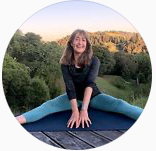The Still Point
At the still point of the turning world,
neither flesh nor fleshless
neither from nor toward
at the still point
there the dance is
but neither arrest nor movement
where past and future are gathered
neither from nor toward
neither ascent or decline
…Except for the point,
the still point,
there would be no dance
and there is only dance.
This piece from TS Eliot–which has haunted my yoga for decades–came to mind recently at a dance performance choreographed by Akram Khan in London. His contribution, Dust, was part of a tribute to those that had suffered the pain and confusion of World War One called Lest We Forget. There was a moment in Dust when all the dancers moved as one body, and it created one of those magical seconds of intense hush in the audience where there is no past and future, no dancer no audience, just breath.
Akram Kahn- Dust 2018
Interestingly enough, the dancers were part of the National English Ballet and this was an unusual collaboration for Akram. He commented that although he had avoided collaborating with classical ballet companies before and working in pointe made him cry!, he admired classically trained bodies partly because he had been trained classically in Indian Kathak dance. “My biggest heroes...growing up were Nureyev and Baryshnikov – with them the art and craftsmanship was such that it’s no longer important what form it is any more.”
The previous two dances in this program by other modern choreographers, although exquisitely executed with all the visual delights of classical ballet, did not touch this quiet resonance within. As a yoga teacher who has worked with dancers over the years, and my own wobbly sense of inner and outer “performance,” I found myself doing what I usually do in the presence of this awesome but demanding art form, sending metta to the dancers’ feet in pointe and their very overworked joints!
Khan’s piece was different. The energy of the dance arose from the writhing form of the central dancer and was echoed through the arms and legs of the troupe. For a brief second in the whirl and flow of limbs there was a sense of deep stillness, timelessness as if something much, much bigger was going on. The technique was subordinate to the flow of multiple bodies moving as one, from the inside to the out. And at the same time, the craftsmanship and finesse had a lot to do with Akram’s essence being expressed so powerfully and making sure we didn’t forget the angst of this horrendous story in our past.
As yoga practitioners we know these moments: when stillness becomes movement and movement stillness, the ego mysteriously evaporating. But we also know times when no matter how adept our craft of asana is, it can become limiting, performance-based and externally oriented, losing the quality of our original intention to practice. How do we cultivate this quietness in movement, this presence? Fortunately in yoga, we don’t need massive orchestras and the grueling regime of rehearsal to bow to the sacred! In the middle of an asana, we pause, come back to the breath, to the moment of being rather than becoming. Yoga helps us in the everyday of our mundane realities. Walking down a busy street, doing the laundry, engaged in a challenging conversation, we come into the center of our bodies, experience whatever reality, whatever state of decay our body is in!, from an embodied, compassionate place.
Of course, this sense of being at the center of the spinning world can be enhanced more specifically depending on how you approach the practice. For myself, Eliot’s words come up often in teaching and my own practice, when moving from the belly or interior body. In our modern yoga, tremendous evolution has occurred in our collective performance and creative levels. However, we often miss the simplicity of the still point, and the possibility of moving from that quiet place, that place that brings resonance and cohesion to the whole. Influenced by belly deities such as Angela Farmer and Victor van Kooten, inspired by pioneers in the explosion of Body Mind explorations from Feldenkrais to early Pilates, Continuum, BodyMind Centering TM, and experiences in dance and the arts world such as the above, has helped many of us remember that interior hearth which reconnects us to that which drew us into yoga in the first place. This is so easily lost when all emphasis is moved into a more external performance mode, which, as in ballet, can be the precursor to many of the typical of injuries and imbalances we are seeing in our yoga world these days.
Imagery can also aid and abet this process. Most of the time, we live on the rim of the wheel of existence, getting bashed and battered by the rocks and mud of the road we travail. A meditative approach can remind us to drop into the hub of being and hence see the splashes, mud and grime of existence for what it is. The circumstances of our lives may be the result of a complex web of karma and seemingly unchangeable. However we can always–as many of my Vipassna teachers in different guises have encouraged–come to the center of the hub of this wheel—the point that doesn’t move.



